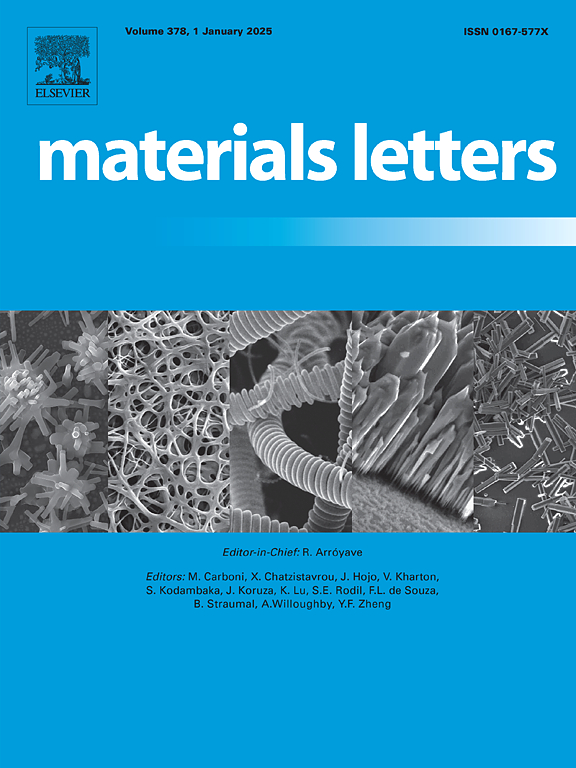羧甲基纤维素辅助制备用于高效铀浓缩的防污磁性金属有机框架纳米复合材料
IF 2.7
4区 材料科学
Q3 MATERIALS SCIENCE, MULTIDISCIPLINARY
引用次数: 0
摘要
采用溶热和原位生长法制备了一种磁性金属有机框架纳米复合材料(FCMCZA),用于高效防污和铀富集。通过 SEM、XRD、XPS、FTIR 和 N2 吸附-解吸分析进行了一系列表征测试。结果表明,FCMCZA 具有明显的核壳结构、高比表面积(793.86 m2/g)和丰富的官能团。FCMCZA 的饱和磁化率和藻类死亡率分别达到了 33.5 emu/g 和 41%。根据 Langmuir 模型计算,在 pH 值为 8.0 时,FCMCZA 的最大吸附容量为 238.66 mg/g。重要的是,四次循环后,FCMCZA 的去除能力仍为 87.29 mg/g。在实际海水中的高去除率(62.9%)和铀吸收率(11.7 μg/g)进一步证明了其应用潜力。本文章由计算机程序翻译,如有差异,请以英文原文为准。
Carboxymethyl cellulose-assisted preparation of magnetic metal–organic framework nanocomposites with antifouling for efficient uranium enrichment
A magnetic metal–organic frameworks nanocomposite (FCMCZA) was prepared by solvothermal and in situ growth method for efficient antifouling and uranium enrichment. A series of characterization tests were carried out by SEM, XRD, XPS, FTIR and N2 adsorption–desorption analyses. The FCMCZA exhibited the distinct core–shell structure with high specific surface areas (793.86 m2/g) and abundant functional groups. The saturated magnetization and algae death rate of FCMCZA reached 33.5 emu/g and 41 %, respectively. The maximum adsorption capacity of FCMCZA was 238.66 mg/g at pH 8.0, calculated from Langmuir model. Importantly, the removal capacity of FCMCZA remained 87.29 mg/g after four cycles. The high removal rate (62.9 %) and uranium uptake (11.7 μg/g) in actual seawater further proved its application potentiality.
求助全文
通过发布文献求助,成功后即可免费获取论文全文。
去求助
来源期刊

Materials Letters
工程技术-材料科学:综合
CiteScore
5.60
自引率
3.30%
发文量
1948
审稿时长
50 days
期刊介绍:
Materials Letters has an open access mirror journal Materials Letters: X, sharing the same aims and scope, editorial team, submission system and rigorous peer review.
Materials Letters is dedicated to publishing novel, cutting edge reports of broad interest to the materials community. The journal provides a forum for materials scientists and engineers, physicists, and chemists to rapidly communicate on the most important topics in the field of materials.
Contributions include, but are not limited to, a variety of topics such as:
• Materials - Metals and alloys, amorphous solids, ceramics, composites, polymers, semiconductors
• Applications - Structural, opto-electronic, magnetic, medical, MEMS, sensors, smart
• Characterization - Analytical, microscopy, scanning probes, nanoscopic, optical, electrical, magnetic, acoustic, spectroscopic, diffraction
• Novel Materials - Micro and nanostructures (nanowires, nanotubes, nanoparticles), nanocomposites, thin films, superlattices, quantum dots.
• Processing - Crystal growth, thin film processing, sol-gel processing, mechanical processing, assembly, nanocrystalline processing.
• Properties - Mechanical, magnetic, optical, electrical, ferroelectric, thermal, interfacial, transport, thermodynamic
• Synthesis - Quenching, solid state, solidification, solution synthesis, vapor deposition, high pressure, explosive
 求助内容:
求助内容: 应助结果提醒方式:
应助结果提醒方式:


